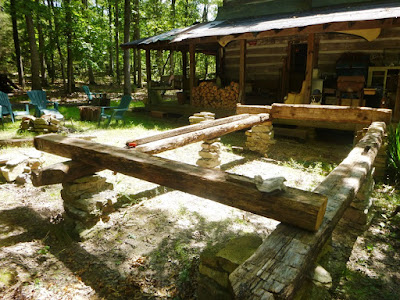Last spring I made good progress on the foundation and setting the first two logs.
Hot weather and daughter sports kept me from working on it all summer. Darn.
But this weekend allowed me time to start up again.
Here you can see the third log placed and ready to be notched.
Here I made the first diagonal notch on one of the base logs (sill log).
The first notch on most sill logs for some reason is just this simple diagonal sill notch. The next log on top of that will have a matching notch. After the base logs (sill), builders would use either a 'V' notch or some sort of dovetail.
Occasionally a flat notch. or rounded 'saddle' notch on softer woods.
Axe, chisel, chainsaw and hammer were the tools for the day.
I am having to remove the original notches to make my diagonal base notches.
On this one you can still see the tag from my numbering system when I first took this old log building down over twenty years ago.
This notch is a 'V' notch, but not in very good shape with the ends damaged.
Here is the log with the old notch removed.
Look how good the wood is on the inside after being down for over one hundred and fifty years.
I made a cardboard template from my first notch and then scribed the pattern into the next log to go on top.
Cut out and ready to set.
Two pieces of the puzzle.
Fit together.
I then did the same thing to the opposite end.
How it sets on the other two logs.
Second log for the day (fourth log in all) up on the base and ready for notching.
Another old notch removed.
On this one you can see the old Adz and axe marks. And my numbering tag.
Two old square nails I removed before my chainsaw caught them.
Both logs notched and the log set.
Here you can see the third log of the day (log five) up and ready to be worked on.
The extra length, or cantilever, will allow me to extend the logs slightly past the sill logs.
This longer log at the back will start the next course.
Its purpose in the cabin I took down was one of the two logs supporting the second story floor joists.
While still not notched, level is right on.
Now I have to make sure that stays true after I notch it.
Bone yard of old notches.
How to move 300 - 700 pound logs on your own. (Probably the reason I have a hernia:)
When working on the big house I had an old tractor to help me move the logs around the lot.
Still, sometimes the logs had to be moved into place by hand to places the tractor could not get.
No tractor this time so, . . .with a good hauling rope. . .
. . . and a couple round logs or pipes I could roll them pretty far and get them right up to the project.
Just don't get in the way once they start to move.
Getting them up on the foundation still requires effort and ramps.
I will keep you posted on the project as fall moves along.






















No comments:
Post a Comment